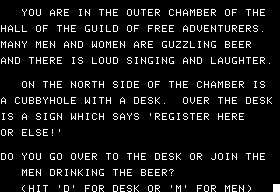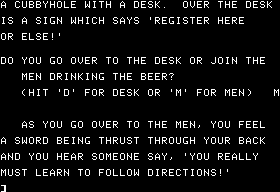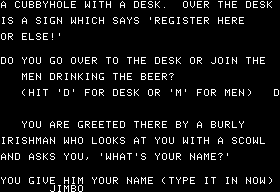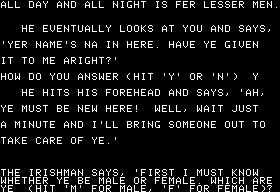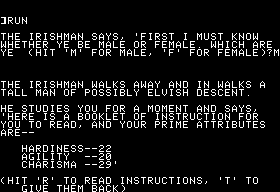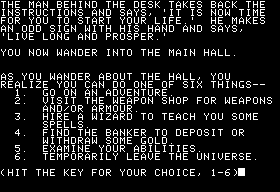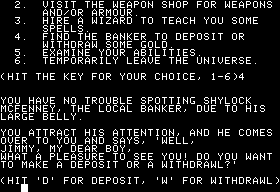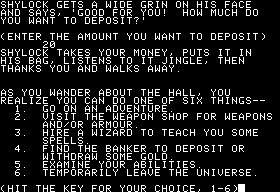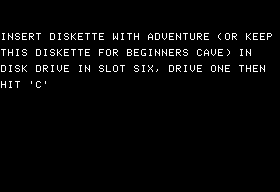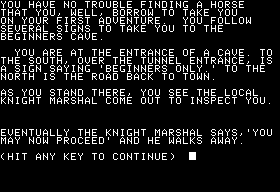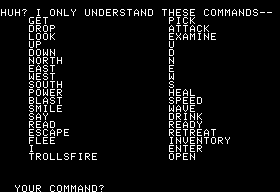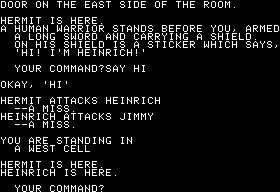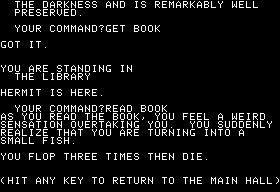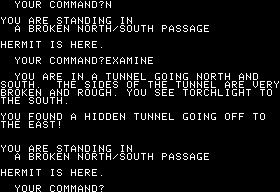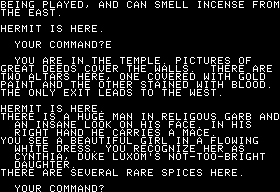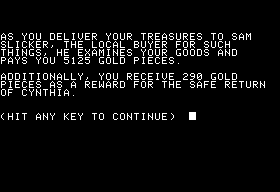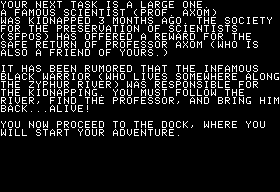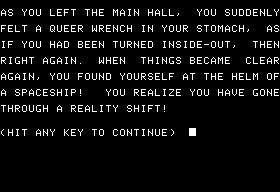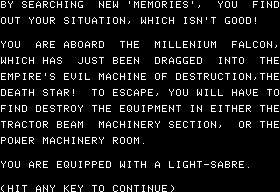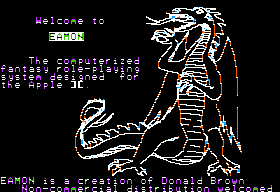Fair warning — this post is going to be a bit meta. It has two purposes. The first is easily dispensed with: to tell you that I’ve revised my earlier posts on the history of Eamon to reflect what I believe to be a more supportable chronology which does not have the system appearing until late 1979. The rest of what follows describes briefly how I came to my conclusions. This is all rather inside baseball, but those of you thinking of growing up to become digital antiquarians yourselves might be interested in this slice of my poor detail-obsessed life.
Traditional histories have given Eamon a release date of 1980, presumably because the first published article about the system, a piece written by Don Brown himself for Recreational Computing, dates from the summer of that year. I initially saw no reason to doubt the traditional chronology. But then I made contact with John Nelson, founder of the National Eamon Users Club. He dropped a bomb on me by saying he had first played Eamon in 1978, and that at that time there were already four additional scenarios available. As the guy who probably did more for Eamon than anyone else, including its creator, Nelson was a hard fellow to doubt. So I wrote those posts based largely on his chronology, even though I never could manage to feel really confident in it. Ever since, those posts have remained the ones I’m least happy about. My dissatisfaction was such that I recently started rummaging through all of the early Eamon disks again, looking for something that would let me pin a definite date onto at least one of them, and thereby begin to build a chronology. As it happened, I found what I was looking for, and that in turn prompted me to revise the earlier articles and write this post. Before I tell you what I found, however, let me first state some of the misgivings that sent me looking in the first place.
The Apple II actually had two versions of the BASIC language. The original machine had in its ROM a very stripped-down version of the language, one that had been put together quickly by Steve Wozniak himself. This version was soon dubbed “Integer BASIC” because it had no support for floating-point (i.e., decimal) numbers, only integers. Because floating-point numbers are very important to certain types of applications, Apple quickly realized the need for a better, more complete implementation of BASIC. They bought one from Microsoft and spent considerable effort customizing it for the Apple II. They dubbed it Applesoft BASIC upon its release in January of 1978. Applesoft was initially not widely used, however, both because its earliest incarnation was quite buggy and because it was housed on tape or disk rather than in ROM, meaning the user had to load it into RAM to use it. With most machines still equipped with only 16 K of memory in these early days, Applesoft, which consumed 10 K by itself, was impractical for most users. It only really caught on from May of 1979, when Apple began shipping the II Plus with Applesoft in ROM; to run an Integer BASIC program on the II Plus, one had to load that language in from disk.
Yet Eamon is written in Applesoft BASIC. And there’s something else: the standard Eamon needs pretty much all of a 48 K Apple II’s memory. (The master disk did originally contain a special, stripped-down version of the program for 32 K machines.) It’s doubtful that it would even be possible to load Applesoft from disk and still have room for Eamon. Even if it was, a 48 K machine would have been a very unusually powerful one for 1978. After the 48 K Apple II Plus began shipping, however, the larger memory quite quickly became an expected standard.
And there’s the text-adventure chronology problem. Scott Adams first released Adventureland and Pirate Adventure during the second half of 1978 for the TRS-80. These games did not appear on the Apple II until early the following year, where they represent the first text adventures available for that platform. To have developed Eamon in 1978, Brown would have had to either: 1) be aware enough of the TRS-80 world that he played Adams’s games and decided to implement a similarly parser-based interface on the Apple II ; 2) have played Crowther and Woods’s Adventure or one of the other games it spawned on a big institutional computer; or 3) have come up with the concept of the text-adventure interface on his own, from scratch. None of these are impossible, but none seems hugely likely either. Depending on when in 1978 Eamon was released, an early Eamon even creates the somewhat earthshaking possibility that it may have been Brown, not Scott Adams, who first brought the text adventure to the microcomputer. Again, this just doesn’t feel right to me.
And then there’s that Recreational Computing article itself. In it Brown writes, “I know of five additional adventure diskettes.” Nelson, on the other hand, believes that “about 20” adventures were available by 1980. He suggested to me that Brown was perhaps referring to adventures that he himself had not written, but it’s very hard for me to read this sense into the paragraph in question. Nelson’s other suggestion, that the article had just lain on the shelf for many months before being printed, seems equally a stretch. If everything else pointed to an earlier chronology, I could accept such reasoning, but in combination with the other questions it becomes a good deal harder.
And then I found what I was looking for. Eamon #3, The Cave of the Mind, was the first not to be written by Brown himself, being from Jim Jacobson and Red Varnum. At the beginning of one of its programs is an REM statement with an actual date: January 30, 1980. This was enough to tip me back over to something much closer to the traditional chronology, with Brown developing the system in the latter half of 1979 in the wake of the Apple II Plus’s release. Sure, it’s possible that the date in the code of Cave represents a revision date rather than a date of completion or release, even though it doesn’t say this. But weighed together with all the other evidence, I feel pretty confident a later date for Eamon is more likely than an earlier.
None of this is meant to criticize John Nelson, who generously shared his memories with me. It’s just that 30 years is a long time. It’s also possible that Nelson might have played an earlier proto-Eamon, presumably written in Integer BASIC for an Apple II with much less memory, which Brown expanded at a later date into the Eamon we know today. Yet unless some real documentary evidence surfaces, or Brown suddenly starts talking, that remains only speculation.
So, the current Eamon articles still represent something of a best guess, and as such I’m still not entirely happy with them. But I think it’s a better guess than the one I made the first time around. Barring more new data, that will have to do.
